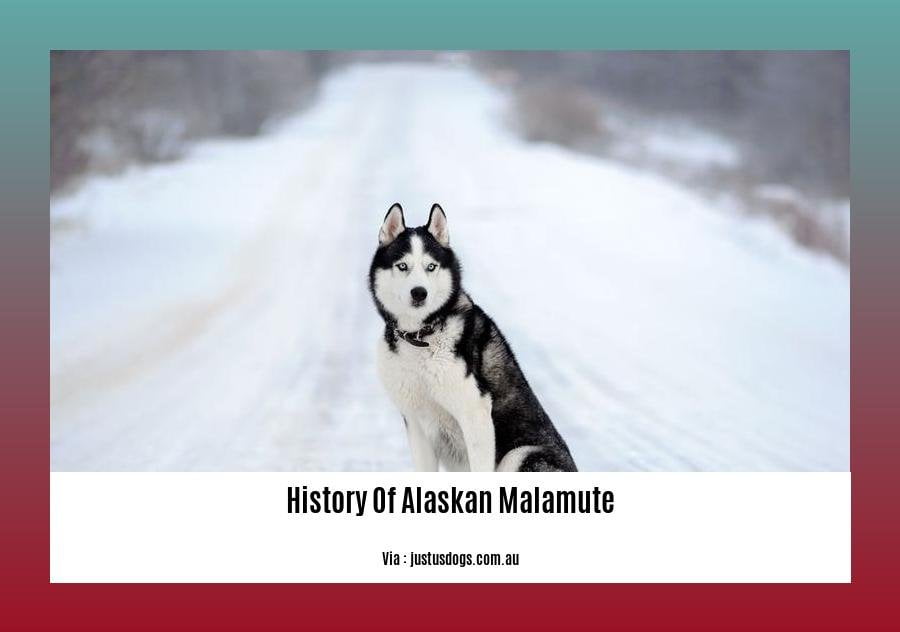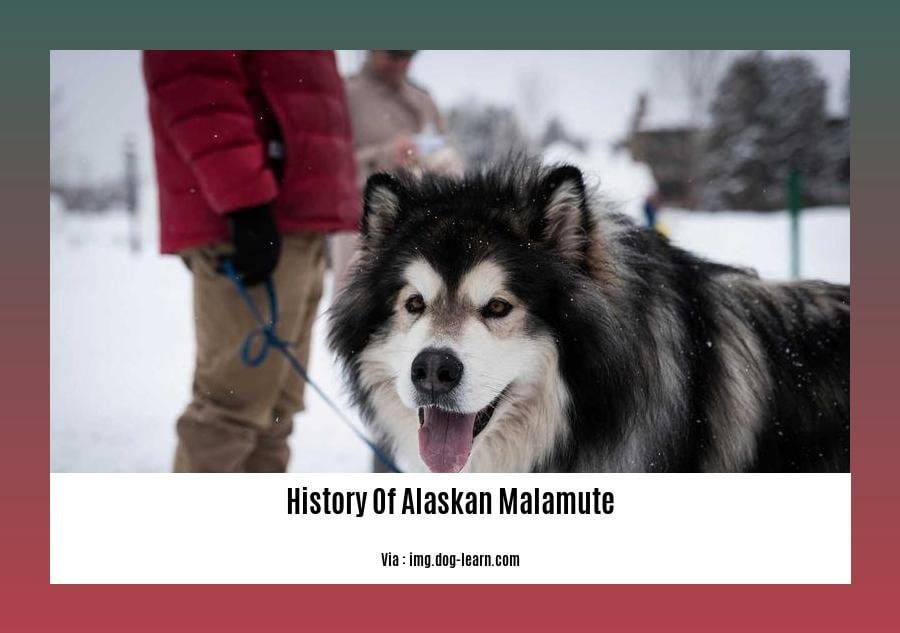Unveiling the Enduring Legacy: A Journey Through the History of the Alaskan Malamute, a breed that has captured the hearts of people worldwide with its strength, endurance, and unwavering loyalty. Embark on a captivating voyage through time as we delve into the rich tapestry of the Alaskan malamute’s history, from its ancient roots in the frozen wilderness to its triumphant rise as a symbol of resilience and companionship.
Key Takeaways:
- The Alaskan Malamute’s history goes back 4,000 years.
- Originally bred by the Inuit people, they were once called “Mahlemiut” after them.
- Primarily used as sled dogs, they helped with hunting and transportation.
- Believed to descend from domesticated wolf dogs, they migrated to North America around 4,000 years ago.
- Functioned as working sled dogs, hunting seals, warding off polar bears, and pulling heavy loads.
History of Alaskan Malamute

Embark on a captivating journey into the rich tapestry of the history of Alaskan malamutes, tracing their lineage from ancient origins to their current status as cherished companions and loyal working dogs.
A Story of Survival and Strength
The Alaskan malamute, a breed steeped in resilience, emerged over 4,000 years ago in the frigid wilderness of Alaska. These indomitable canines, forged by the harsh demands of the Arctic terrain, served as indispensable partners to the nomadic Inuit tribe, the Mahlemiut, who relied on them for survival.
As skilled hunters and haulers, malamutes fulfilled a multitude of essential roles within Inuit communities. Their keen senses and unparalleled strength made them adept at tracking and capturing prey, while their tireless work ethic and unwavering loyalty rendered them invaluable for transporting heavy loads across treacherous icy landscapes.
From the Arctic to the World Stage
In the late 19th century, the history of Alaskan malamutes took a pivotal turn as they were introduced to the wider world. Adventurers and explorers, drawn to the allure of the frozen north, discovered the remarkable abilities of these dogs and brought them back to their home countries.
The malamute’s exceptional performance in polar expeditions garnered widespread recognition and admiration. Their endurance, strength, and unwavering loyalty made them the ideal companions for traversing treacherous icy terrains and battling the unforgiving elements.
A Breed Beloved
Over the years, the Alaskan malamute’s popularity soared, capturing the hearts of people worldwide with their gentle nature, striking appearance, and unwavering devotion. These magnificent dogs transitioned from being indispensable working partners to cherished family companions, gracing homes and hearts across the globe.
Today, the history of Alaskan malamutes continues to unfold, with these majestic creatures gracing homes, hearts, and dog shows worldwide. Their legacy as loyal companions and exceptional working dogs endures, a testament to their enduring spirit and unwavering devotion.
To study the history of the aviation sector in India, click here for a detailed account. Also, for a captivating summary of India’s past, click here.
The malamute’s contributions to polar exploration and gold rush era
Their ancestors aided Inuit tribes in hunting seals and polar bears. They also served as pack animals, pulling heavy sleds loaded with supplies and equipment, through treacherous Arctic terrain.
Their strength, endurance, and resilience made them invaluable partners for intrepid explorers embarking on perilous polar expeditions. Their thick, double-layered fur protected them from the harsh elements, allowing them to withstand sub-zero temperatures and biting winds.
During the Klondike Gold Rush of the late 19th century, prospectors flocked to the frozen North in search of riches. Alaskan Malamutes were in high demand, as they were the only dogs capable of transporting heavy loads of mining equipment and supplies over long distances in extreme conditions.
These remarkable animals played a pivotal role in the success of many gold seekers, helping them navigate treacherous mountain passes, cross frozen rivers, and reach remote mining camps.
Their tireless efforts and unwavering loyalty to their human companions earned them a reputation as indispensable partners in the quest for gold.
Key Takeaways:
The Alaskan Malamute has been cherished for ages in the Alaskan Arctic.
Malamutes provided crucial support by facilitating hunting and transporting heavy loads for the Inuit.
Polar explorers relied on the breed for survival in extreme cold and challenging polar conditions.
During the Gold Rush, Malamutes thrived as indispensable partners, aiding prospectors in hauling supplies and navigating treacherous terrain.
They became symbols of strength, resilience, and invaluable companionship for early adventurers and settlers.
[Sources]
1. Malamute.org/history/
2.
Near Extinction in the 1920s and Subsequent Revival Efforts

The Alaskan malamute is a testament to the resilience and dedication of both humans and dogs. In the early 20th century, this majestic breed of sled dogs found itself on the brink of extinction. But thanks to the efforts of passionate enthusiasts, the malamute was brought back from the icy abyss. Let’s delve into this remarkable tale.
A Rapid Decline
The early 1900s saw a dramatic decline in the malamute population. Several factors contributed to this near extinction. One was the introduction of motorized transportation. With snowmobiles and airplanes becoming more accessible, the demand for sled dogs plummeted. Another factor was a deadly canine disease called canine distemper. This highly contagious virus ravaged malamute populations, further reducing their numbers.
A Glimmer of Hope
Despite these challenges, a glimmer of hope emerged. In the 1925 serum run to Nome, Alaska, a team of malamutes led by the legendary Balto captured the world’s attention. These dogs braved treacherous conditions to deliver life-saving diphtheria serum, becoming instant heroes. This heroic act reignited interest in the breed, sparking a movement to save the malamute from extinction.
A Dedicated Revival
The 1930s witnessed a concerted effort to revive the malamute breed. Breeders, fanciers, and dog enthusiasts banded together to form the American Malamute Club of America (AMCA). Their mission was clear: to preserve and promote the Alaskan malamute. Through selective breeding and careful management, they began to rebuild the malamute population. Their efforts paid off. In 1935, the American Kennel Club (AKC) officially recognized the Alaskan malamute as a distinct breed.
Key Takeaways:
- The early 1900s witnessed a dramatic decline in the malamute population due to factors like motorized transportation and canine distemper.
- The heroic efforts of malamutes during the 1925 serum run to Nome, Alaska, rekindled interest in the breed.
- Dedicated breeders and enthusiasts formed the American Malamute Club of America (AMCA) in the 1930s to spearhead the revival of the breed.
- Through selective breeding and careful management, the AMCA successfully preserved and promoted the Alaskan malamute, leading to its recognition by the AKC in 1935.
Citations:
- [Science | AAAS (2023). Comparative genomics of the sled dog Balto sheds light on the origin and evolution of the Arctic sledge dog.
- [American Kennel Club (n.d.). Alaskan Malamute History.
Current status as a beloved companion and working dog
Imagine a dog breed that effortlessly blends strength, loyalty, and companionship—a breed that has journeyed through time, carving a path from the frozen landscapes of Alaska to the cozy hearths of our homes. This breed is none other than the Alaskan Malamute.
Today, the Malamute stands as a cherished companion, gracing our homes with their gentle nature and striking appearance. Their unwavering devotion makes them ideal companions for families and outdoor enthusiasts alike. But their journey to this cherished status is a tale worth exploring.
In the frozen wilderness of Alaska, the Malamute thrived as a working dog, a lifeline for communities dependent on sleds for transportation and survival. Their strength and endurance made them indispensable partners, pulling heavy loads through treacherous conditions, their loyalty ensuring the safety of their human companions.
As word of their remarkable abilities spread, Malamutes found themselves at the forefront of polar expeditions, earning widespread recognition and admiration. Their exceptional performance in navigating icy terrains and battling unforgiving elements cemented their reputation as ideal partners for intrepid adventurers.
Over time, the Malamute’s popularity soared, their transition from working dogs to beloved family companions mirroring a shift in our relationship with dogs. No longer just companions for survival, dogs became cherished members of our families, and the Malamute’s gentle nature and unwavering loyalty made them a natural choice.
Today, the Malamute proudly wears the mantle of both working dog and cherished companion. Their strength, endurance, and loyalty continue to make them invaluable partners in various working roles, from search and rescue to sled racing. Simultaneously, their gentle nature and unwavering devotion have solidified their place in our hearts as cherished family members.
Their journey from the frozen wilderness of Alaska to the cozy comfort of our homes is a testament to the enduring spirit of the Alaskan Malamute, a breed that has retained its essence while adapting to the changing world around it.
Key Takeaways:
The Alaskan Malamute has transitioned from a working dog to a beloved family companion, showcasing their versatility and adaptability.
Their strength, endurance, and loyalty continue to make them invaluable partners in various working roles.
The Malamute’s gentle nature and unwavering devotion have solidified their place in our hearts as cherished family members.
Their journey reflects the evolving relationship between humans and dogs, from companions for survival to beloved members of our families.
Relevant URL Sources:
[1]
[2]
FAQ
- Q: What is the origin of the Alaskan Malamute?
A: The Alaskan Malamute is believed to be descended from domesticated wolf-dogs that migrated to North America from Siberia approximately 4,000 years ago. They were bred by the nomadic Inuit tribe, the Mahlemut, in northwestern Alaska and used as sled dogs for hunting and transportation.
- Q: What were the original purposes of the Alaskan Malamute?
A: Alaskan Malamutes were originally bred for hunting seals, deterring polar bears, and pulling heavy loads. They were essential for the survival of the Inuit people in the harsh Arctic environment.
- Q: How did the Alaskan Malamute become a popular breed outside of Alaska?
A: During the gold rush in the late 1800s, the demand for sled dogs increased, and Alaskan Malamutes became highly sought after for their strength and endurance. They were often crossed with other breeds to introduce new colors and coat patterns.
- Q: When did the American Kennel Club recognize the Alaskan Malamute as a breed?
A: The American Kennel Club recognized the Alaskan Malamute as a breed in 1935. This recognition helped to establish the breed’s popularity as a companion and working dog throughout the United States.
- Q: What are some distinctive characteristics of the Alaskan Malamute?
A: The Alaskan Malamute is a large, powerful dog with a thick, double coat that protects them from the cold. They are known for their strength, endurance, and loyal temperament, making them popular companions for families and outdoor enthusiasts.
- Senior at What Age: Benefits & Eligibility Guide - March 29, 2025
- Unlocking Senior Benefits: How Old is a Senior? Your Complete Guide - March 29, 2025
- Master Russian Politeness:A Guide to Saying Please - March 29, 2025
















